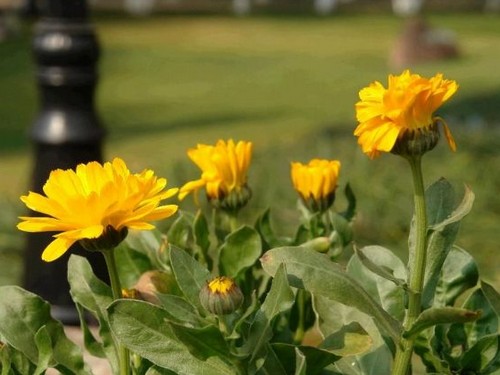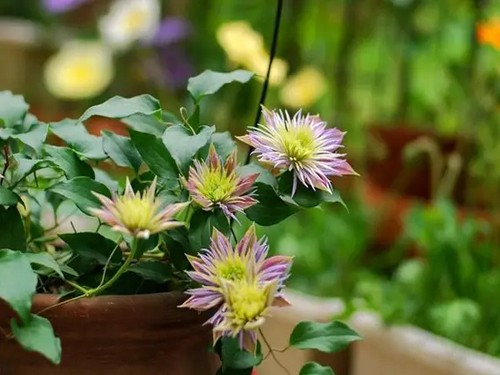Culture methods and matters needing attention of potted Calendula
With short plants, dense flowers, bright colors and long flowering period, calendula is the most common herbaceous flower in early spring gardens and cities. Calendula is colorful and is one of the common flower plants. It is not uncommon for potted plants to decorate the home. The following introduces the breeding methods and matters needing attention of Calendula!

[shading in spring, summer and autumn]
Calendula can not be exposed to strong light, spring, summer and autumn need to be shaded in time, if the temperature during the day exceeds 25 ℃, do not put directly in the sun, otherwise the leaves will obviously become smaller, the distance between the branches will shrink, the leaves at the bottom will gradually turn yellow and fall off, and the growth of the plant will gradually slow down and even infiltrate the semi-dormant state.
In winter, because the temperature is not high, it can give direct light and promote photosynthesis, which is conducive to the formation of flower buds, flowering and fruiting of calendula.
After the plant blossoms, the plant can be maintained indoors for 10 to 15 days, and then moved to the outdoor shade environment for one month, so alternate maintenance is conducive to the accumulation of plant nutrients and prolong the flowering period.
[to be warm, avoid extreme heat]
Calendula likes warm climate and is afraid of extreme heat. If the summer temperature is higher than 34 ℃, it will grow poorly.
Not resistant to frost and cold, the winter temperature below 4 ℃ will enter dormancy or even death.
The most suitable growth temperature of marigold is 15-25 ℃. In the maintenance of the whole year, attention should be paid to the control of temperature, timely opening of windows and cooling by spraying water to control the indoor temperature.
[heart-picking pruning]
Cut off the branches with old and yellow leaves every two months, as long as the temperature is right, it can blossom all the year round.
Coring is usually carried out twice before flowering to promote the germination of more flowering branches: one to two weeks after potting, or when the seedling is 6-10 cm tall and has more than six leaves, remove the tip and retain the lower 3-4 leaves to promote branching. After 3-5 weeks of the first coring, or when the lateral branch grows to 6-8 cm long, the second coring is performed, that is, the top tip of the lateral branch is removed and the 4 leaves under the lateral branch are retained. After two coring, the plant type will be more ideal and the number of flowering will be more.
[control humidity, spray water in time]
Calendula likes humid environment, control humidity at 75-85%, spray water in time to increase humidity during maintenance, 1-3 times a day, higher temperature in sunny days, appropriately increase the frequency of water spraying, lower temperature in cloudy and rainy days and reduce water spraying times appropriately. But excessive spray, heading is easy to be infected by bacteria and rot, so spray should also pay attention to the water quality.
[matters needing attention in marigold culture]
1. Pay attention to water control
Don't water too much during the growth period, just keep the soil moist. Spray in time when the temperature is high, increase air humidity.
2. Disease and pest control
The common diseases and insect pests of calendula are Fusarium wilt and downy mildew. Timely spraying Dysen zinc wettable powder 500 times solution to control. When the temperature rises gradually in early summer, leaf spot disease often occurs in calendula. 2000 times of Weiruling wettable powder is sprayed to prevent and cure it.
Time: 2019-06-01 Click:
- Prev

Culture method of calendula (Calendula)
Calendula, also known as marigold, is a plant of the genus Calendula in Compositae. It is often used in flower beds and is native to southern Europe. Calendula is one of the common flower plants with bright colors. It is not uncommon for potted plants to decorate homes. It is suitable for flower beds and flower belts, and can also be used as lawn border flowers or potted plants to watch.
- Next

Culture methods and matters needing attention of potted clematis
Many flower friends are impressed by the beauty of clematis. They want to raise clematis but do not know whether clematis is easy to raise. If you have to evaluate the planting difficulty of clematis, the editor thinks that it is moderately difficult to grow clematis, because it does not want to be so skinny, such as hanging orchids. But it is not a very hypocritical flower, so if you want to raise clematis.
Related
- Fuxing push coffee new agricultural production and marketing class: lack of small-scale processing plants
- Jujube rice field leisure farm deep ploughing Yilan for five years to create a space for organic food and play
- Nongyu Farm-A trial of organic papaya for brave women with advanced technology
- Four points for attention in the prevention and control of diseases and insect pests of edible fungi
- How to add nutrient solution to Edible Fungi
- Is there any good way to control edible fungus mites?
- Open Inoculation Technology of Edible Fungi
- Is there any clever way to use fertilizer for edible fungus in winter?
- What agents are used to kill the pathogens of edible fungi in the mushroom shed?
- Rapid drying of Edible Fungi

